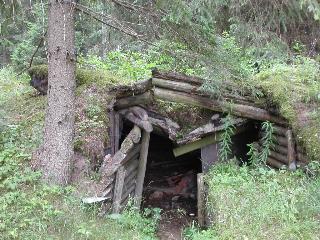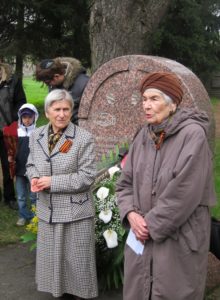◊
by Dovid Katz
◊
Fania Yocheles Brantsovsky, born in 1922, who lost her entire family in the Holocaust, escaped the Vilna Ghetto several moments before it was encircled by police preparing for its final liquidation on 23 September 1943. Together with Dobke Develtov [update: who passed away in 2012 in Los Angeles], she made it to this underground anti-Nazi partisan fort that was home to fighters aligned with the Soviet partisans. The precise number of inhabitants varied with newcomers and deaths in battle. Fania remembers at one time 99 of 101 were Jewish Vilna Ghetto escapees, at another 101 of 107. An underground bunker like this was home until the fall of Nazi rule in July 1944.
Along with other Holocaust Survivors who resisted — including Yitzhak Arad and Rachel Margolis — Ms Brantsovsky, librarian of the Vilnius Yiddish Institute, has in recent years been the object of a campaign of defamation and harassment in Lithuania.
The antisemitic press has targeted her (January 2008). Armed police came to search for her (May 2008). Prosecutors told the press she could not be found (May 2008). The editor of Lithuania’s main news portal called for her to be tried (May 2009). The mainstream media, citing ruling-party members of Lithuania’s parliament, branded her a war criminal (Oct 2009). And one of the country’s leading associations for human rights (!) demanded that she and other Jewish partisan veterans be ‘sentenced’ for committing ‘a massive slaughter’ (Dec. 2010).
All in the absence of any charge or iota of evidence.
“I dream that good people from all over the world will not forget the Holocaust in Lithuania or our struggle to stay alive and to fight the Nazis and their collaborators, that for generations to come they will make their way here to look and see where we, a hundred Vilna Ghetto survivors who lost our entire families, lived, loved, fought, and dreamt of a better tomorrow.” — Fania Yocheles Brantsovsky
See Defending History’s Fania Yocheles Brantsovsky Section
In the opinion of this journal, the entire charade is a ruse of the red-brown movement and its local and powerful Double Genocide Industry. This is the part of the effort to rewrite history that specializes in generating bogus paper trails of ‘equal investigation’ of perpetrators and victims in order to obfuscate the Holocaust; the ‘equality of investigation’ is then triumphantly trumpeted by diplomats and politicians in service to the red-equals-brown movement. To many in the international community it is quite outrageous, bearing in mind the dismal record of Lithuanian prosecutors in bringing to justice Nazi war criminals, not a single one of whom was ever punished, howsoever slightly, in modern, independent Lithuania.
In the meantime, representatives of the free world, from western ambassadors to Lithuania to the president of Germany have honored Ms Brantsovsky as a hero of the Jewish resistance against Nazism (see: Responses). It is verily the first occasion in the country since Soviet times that western powers have seen fit to honor individuals trashed by prosecutors and politicians.
 While relics of the anti-Soviet struggle are (rightly) preserved in the Baltics, historic monuments celebrating the inspiring courage and heroism of the anti-Nazi resistance are being allowed (and ‘encouraged’) to rot into the earth. One of them is this fort, where Fania and some hundred Vilna Ghetto survivors lived, and which they used as their base during the fight against the awesome power of the Nazi army and its multitudinous local partners. Images (by Adalbert Wagner) available here [2019 update: now here].
While relics of the anti-Soviet struggle are (rightly) preserved in the Baltics, historic monuments celebrating the inspiring courage and heroism of the anti-Nazi resistance are being allowed (and ‘encouraged’) to rot into the earth. One of them is this fort, where Fania and some hundred Vilna Ghetto survivors lived, and which they used as their base during the fight against the awesome power of the Nazi army and its multitudinous local partners. Images (by Adalbert Wagner) available here [2019 update: now here].
In the summer of 2008, a group of NATO ambassadors arranged to visit the fort formally, but the plan was thwarted by a protest from the Lithuanian Foreign Ministry. Groups of Western ambassadors simply proceeded to organize private visits to the fort, led by Fania, starting in November 2008, and proceeding uninterrupted to the present day.
 The potent symbolism of the Jewish Partisan Fort has been noted in connection with the international effort to honor and defend from defamation the Jewish resistance heroes who fought the Nazis in the forests of Lithuania. In an early public reaction (3 April 2008), the unanimous resolution of the Friends of the Vilnius Yiddish Institute concluded with the words: ‘including the underground forest fort outside today’s Vilnius, which, it is hoped, will be preserved for posterity as a monument to the indomitable human striving for freedom from oppression’. Over the years, Fania Yocheles Brantsovsky and other Holocaust educators have guided visitors and students to the site, which has enormous educational potential.
The potent symbolism of the Jewish Partisan Fort has been noted in connection with the international effort to honor and defend from defamation the Jewish resistance heroes who fought the Nazis in the forests of Lithuania. In an early public reaction (3 April 2008), the unanimous resolution of the Friends of the Vilnius Yiddish Institute concluded with the words: ‘including the underground forest fort outside today’s Vilnius, which, it is hoped, will be preserved for posterity as a monument to the indomitable human striving for freedom from oppression’. Over the years, Fania Yocheles Brantsovsky and other Holocaust educators have guided visitors and students to the site, which has enormous educational potential.
Please contact your elected officials, anywhere in the world, asking them to encourage authorities in Lithuania responsible for historic sites to secure, preserve and protect the site as a vital monument to the noble universal human struggle for freedom from tyranny and genocide.
Another famous veteran of this forest fort is Vilna native Avreml Zeleznikow (Zheléznikov; born 1924), a resident of Melbourne, Australia whose life was immortalized in Arnold Zable’s Café Scheherazade (2001).
When you visit the region, do be sure to view this unique site, some 25 miles southwest of Vilnius, in the Rudninkai Forest (famous in Holocaust memoirs and lore by its Yiddish name, der Rudnitsker vald). A number of Holocaust Survivors refer to the fort as der Rudnitsker fort. In English, the phrase ‘Jewish partisan fort’ has become a shibboleth of competence. If your guide in Lithuania knows his or her stuff, you’ll be taken there without delay. If you get the ‘It’s only woods, nothing there’ spiel, you’ll know where that is coming from…
Articles on Fania: Annemieke Hendriks in Frije Nederland, 21 November 2009.
♦
In the Vilna Ghetto

♦
With her family at their shop and residence, 1932 or 1933

In happier times, outside her parents’ shop on Zavalna (now Pylimo) in 1932 or 1933. From left: Fania; younger sister Rivele; their parents: Benyomen Yocheles, a teacher at Vilna’s Jewish Technical College and owner of the electrical workshop in the background; Rokhl Galunsky-Yocheles. Using a time-delay device, the photographer (far right, name unknown) jumped into the picture. Fania is the only one in the image to have survived the Holocaust. She fled the ghetto just before its destruction and joined a unit of Jewish partisans in the forest. She frequently takes visitors and students to the site of the Jewish partisan fort where she lived and fought from September 1943 until July 1944. The remnants of the fort are in danger of imminent disappearance.
♦
Celebrating Purim 1933
Celebrating Purim 1933 with fellow pupils at the fabled Sofia Gurevich Yiddish school on Makova (now Aguono gatve). Fania (marked by arrow) is dressed as a Chinese woman with a fan.
♦
2010-2012 Updates
28 April 2010. The U.S. president’s Special Envoy to Monitor and Combat Antisemitism, Hannah S. Rosenthal, visited the Jewish Partisan Fort, guided by its one surviving veteran in Lithuania, Fania Yocheles Brantsovsky, librarian of the Vilnius Yiddish Institute. The visit was coordinated by the U.S. Embassy’s Timothy O’Connor, and included this website’s editor, who provided translation for Ms Brantsovsky. During the excursion, Ms Rosenthal expressed the hope that the Lithuanian government would take action to preserve the site as one that is vital to Holocaust education and the honoring of Jewish resistance against Nazi tyranny.
22 May 2010. Fania celebrates her 88th birthday in Vilnius with family, friends and admirers. Tributes on Facebook.
12 October 2010. Fania does a nighttime interview with the BBC World Service at the partisan fort. She was interviewed by radio and television presenter Wendy Robbins (left); sound engineer Yaba Badoe is at right. The program, broadcast in December 2010, is available here.

8 May 2011. Fania with fellow Vilna Ghetto survivor and Jewish partisan veteran Chasia Langbord Shpanerflig, preparing to sing together the Jewish partisan hymn, Zog nit kéynmol az du géyst dem létstn vég at the annual memorial for veterans held at the Jewish cemetery in Vilnius on the eve of May 9th, near the monument to the F.P.O. (Faréynikte Partizáner Organizátsye — United Partisans Organization). Video here.
21 June 2011. The Forward includes the fort in its survey of Top 10 Overlooked Jewish Heritage Sites From Around the Globe, compiled by Michael Luongo.





